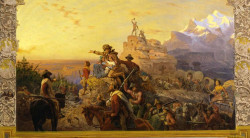Travis Meserve's collections
Native Americans and Manifest Destiny
<p>A collection of images focusing on the Native Americans and their vanishing cultures due to Manifest Destiny.</p>
<p><strong>Lesson Concept<span></span></strong><br /></p>
<p>Travis Meserve</p>
<p>Bowling Green High School, Bowling Green, KY</p>
<p>Grade levels: 9-12</p>
<p>11th grade American Literature Focus for English Second Language Learners</p>
<p>Lesson Time: 50 minutes</p>
<p>Procedure:</p>
<p>1. Show the students a copy of the painting “Westward the Course of Empire Makes Its Way” by Emanuel Leutze (1861). Ask the students to spend a few moments observing the work in silence, noticing any details that draw their eyes. Ask the students to let their eyes touch every part of the canvas/picture.</p>
<p>2. Using the teaching strategy “See Think Wonder” ask the students to volunteer details in the work that they see. Ask them to describe only what they observe in the work (e.g. “I see a man in a fur hat holding a gun”). After the student makes a factual observation, ask the student “What do you see that makes you say that?” if the student says something that is not immediately obvious (e.g. the student sees a wooden sailing ship trapped in sea ice but describes it as a cabin). Do not correct the student. Let other students make observations and possibly correct each other through observation and discussion. After the student is satisfied with an observation, follow up with the question “What do you think about that?” Allow the student to offer any interpretations of what the detail means for the content of the work, the tone, the theme etc. Avoiding any value judgements, summarize back to the student his or her interpretation and evidential observations supplying any vocabulary the student might lack, asking for the student’s approval of the final summary. Continue this procedure until the students exhaust their observations or the class time restraints are reached. Finally, follow up with the question “What does this work (or specific observation) make you wonder about?”</p>
<p>3. At this point, ask the students to note anything that they do not see but would expect to be represented in the scene. Second Language Learners who have been in the USA for 2-3 years would probably have some general ideas about the history of the USA and may be able to offer such absences. If not, the teacher may need to point out that no Native Americans appear in the main scene. If the students do not notice the border of the work, point out that there are small scenes in the border that add content/connections to the main scene. Point out that two Native Americans appear there, small and crawling.</p>
<p>4. Ask the students to make a journal entry writing their thoughts about the work, specifically noting the Americans who are represented as moving across the land and the Americans who are not represented.</p>
<p>Extensions:</p>
<ol><li><p>If the students have enough command of the language, the teacher can discuss representing fact versus propaganda. Discuss the painting as advertisement for the movement west despite its factual inaccuracies (e.g. the painting depicts California as visible from the Rocky Mountains although it is actually 1,200 miles away). Contrast this with a handbill distributed in the Dust Bowl areas advertising workers needed in California to pick crops (in reality the number of workers was greater than the jobs available). A possible literary connection could be to <em>The Grapes of Wrath</em>.</p></li><li><p>Use the painting periodically through the course of American Literature. Students’ reactions to the work may evolve as they expand their ideas of American history, manifest destiny, and the immigrant experience. Allow students to write new journal entries each time they revisit the work with new knowledge. Discuss the dialogue that gets created between the artist, the work, and the viewer based on what the viewer brings to the experience.</p></li></ol><p>Purpose</p>
<p>Objective: The student will be able to make a factual observation about the painting and offer interpretation (where possible) citing evidence from the work.</p>
<p>Follow-up lessons: On subsequent viewing of the work, the student will be able to identify themes in the painting that connect to texts from American Literature (e.g. attitude toward nature, the west, immigration, manifest destiny, etc.)</p>
<p>Rationale for using this artwork: The painting by Leutze encapsulates many themes that permeate American Literature and lends itself to an introduction to the course as well as an anchor for the course that will bear repeated viewing.</p>
<p>Rationale for the the methodology: The English as a Second Language student often does not bring a lot of background knowledge about American history or art. The See-Think-Wonder technique allows the student to engage with the work as an expert would: one who makes observations and interpretations that allow claims backed by evidence.</p>
<p>Skills:</p>
<p>Differentiating Observation (fact) from Interpretation (opinion).</p>
<p>Making claims based on evidence.</p>
<p>Practice speaking in front of peers using the target language of English.</p><p>#SAAMteach<br /></p>
<p><br /></p>
 Travis Meserve
Travis Meserve
28


